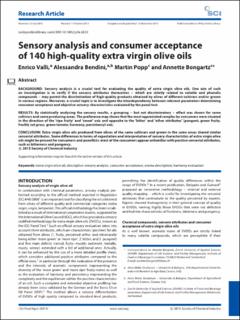Bitte benutzen Sie diese Kennung, um auf die Ressource zu verweisen:
https://doi.org/10.21256/zhaw-1863| Publikationstyp: | Beitrag in wissenschaftlicher Zeitschrift |
| Art der Begutachtung: | Peer review (Publikation) |
| Titel: | Sensory analysis and consumer acceptance of 140 high-quality extra virgin olive oils |
| Autor/-in: | Valli, Enrico Bendini, Alessandra Popp, Martin Bongartz, Annette |
| DOI: | 10.21256/zhaw-1863 10.1002/jsfa.6535 |
| Erschienen in: | Journal of the Science of Food and Agriculture |
| Band(Heft): | 98 |
| Heft: | 4 |
| Seite(n): | 2124 |
| Seiten bis: | 2132 |
| Erscheinungsdatum: | 2014 |
| Verlag / Hrsg. Institution: | Wiley |
| ISSN: | 1097-0010 0022-5142 |
| Sprache: | Englisch |
| Schlagwörter: | Aroma description; Extra virgin olive oil; Harmony evaluation; Descriptive sensory analysis |
| Fachgebiet (DDC): | 664: Lebensmitteltechnologie |
| Zusammenfassung: | Background: Sensory analysis is a crucial tool for evaluating the quality of extra virgin olive oils. One aim of such an investigation is to verify if the sensory attributes themselves – which are strictly related to volatile and phenolic compounds – may permit the discrimination of high-quality products obtained by olives of different cultivars and/or grown in various regions. Moreover, a crucial topic is to investigate the interdependency between relevant parameters etermining consumer acceptance and objective sensory characteristics evaluated by the panel test. Results: By statistically analysing the sensory results, a grouping – but not discriminatory – effect was shown for some cultivars and some producing areas. The preference map shows that the most appreciated samples by consumers were situated in the direction of the ‘ripe fruity’ and ‘sweet’ axis and opposite to the ‘bitter’ and ‘other attributes’ (pungent, green fruity, freshly cut grass, green tomato, harmony, persistency) axis. Conclusion: Extra virgin olive oils produced from olives of the same cultivars and grown in the same areas shared similar sensorial attributes. Some differences in terms of expectation and interpretation of sensory characteristics of extra virgin olive oils might be present for consumers and panellists: most of the consumers appear unfamiliar with positive sensorial attributes, such as bitterness and pungency. |
| URI: | https://digitalcollection.zhaw.ch/handle/11475/4259 |
| Volltext Version: | Publizierte Version |
| Lizenz (gemäss Verlagsvertrag): | Lizenz gemäss Verlagsvertrag |
| Departement: | Life Sciences und Facility Management |
| Organisationseinheit: | Institut für Lebensmittel- und Getränkeinnovation (ILGI) |
| Enthalten in den Sammlungen: | Publikationen Life Sciences und Facility Management |
Dateien zu dieser Ressource:
| Datei | Beschreibung | Größe | Format | |
|---|---|---|---|---|
| 2013_Valli_2012_Sensory_analysis_and_consumer_acceptance.pdf | 489.52 kB | Adobe PDF |  Öffnen/Anzeigen |
Zur Langanzeige
Valli, E., Bendini, A., Popp, M., & Bongartz, A. (2014). Sensory analysis and consumer acceptance of 140 high-quality extra virgin olive oils. Journal of the Science of Food and Agriculture, 98(4), 2124–2132. https://doi.org/10.21256/zhaw-1863
Valli, E. et al. (2014) ‘Sensory analysis and consumer acceptance of 140 high-quality extra virgin olive oils’, Journal of the Science of Food and Agriculture, 98(4), pp. 2124–2132. Available at: https://doi.org/10.21256/zhaw-1863.
E. Valli, A. Bendini, M. Popp, and A. Bongartz, “Sensory analysis and consumer acceptance of 140 high-quality extra virgin olive oils,” Journal of the Science of Food and Agriculture, vol. 98, no. 4, pp. 2124–2132, 2014, doi: 10.21256/zhaw-1863.
VALLI, Enrico, Alessandra BENDINI, Martin POPP und Annette BONGARTZ, 2014. Sensory analysis and consumer acceptance of 140 high-quality extra virgin olive oils. Journal of the Science of Food and Agriculture. 2014. Bd. 98, Nr. 4, S. 2124–2132. DOI 10.21256/zhaw-1863
Valli, Enrico, Alessandra Bendini, Martin Popp, and Annette Bongartz. 2014. “Sensory Analysis and Consumer Acceptance of 140 High-Quality Extra Virgin Olive Oils.” Journal of the Science of Food and Agriculture 98 (4): 2124–32. https://doi.org/10.21256/zhaw-1863.
Valli, Enrico, et al. “Sensory Analysis and Consumer Acceptance of 140 High-Quality Extra Virgin Olive Oils.” Journal of the Science of Food and Agriculture, vol. 98, no. 4, 2014, pp. 2124–32, https://doi.org/10.21256/zhaw-1863.
Alle Ressourcen in diesem Repository sind urheberrechtlich geschützt, soweit nicht anderweitig angezeigt.